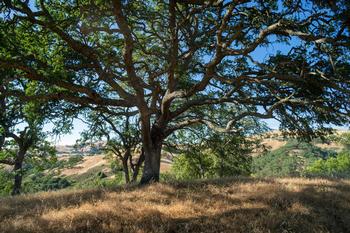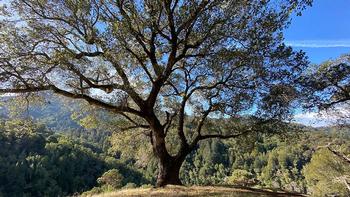Oak trees: something for everyone
-
Marie Narlock
-
"Oaks are key to the character and legacy of California—its visual beauty, the vigor of its rivers and streams, the clarity of its air, the richness of its wildlife." -- Secrets of the Oak Woodlands by Kate Marianchild
 Oak woodlands are an iconic California landscape that supports a vast array of wildlife. Photo: Creative Commons
Oak woodlands are an iconic California landscape that supports a vast array of wildlife. Photo: Creative CommonsStress is in ample supply these days, whether it's aggravation from the news or loneliness from isolation. Perhaps it's time for something uplifting. Something hopeful. Something a UC scientist said symbolizes the values we hold dear: strength, beauty, adaptability, and longevity.
Perhaps it's time to plant an oak tree.
Although California boasts other stately trees, nothing compares to the mighty oak. Scientist and best-selling author Doug Tallamy says it's "the most productive plant in this country."
Please plant an oak. Consider a blue, valley, island, or coast live oak if space allows, or a leather or huckleberry oak for tighter spaces. No room? Hike up Tam or Mount Burdell to enjoy them.
Oaks offer something for everyone.
For ecologists there's no better choice, as there's more life in an oak woodland than any California ecosystem. Oaks are like factories filled with tireless workers day and night 365 days per year. Within the tree canopy, keen-eyed hawks perch while woodpeckers tap tap tap. Grey squirrels twitch and twirl as screech owls roost and hummingbirds nest in cozy lichen. Insects and spiders work silently. The canopy of a mature valley oak is like living sculpture, spreading artfully and gracefully. Photo: Napa Master Gardeners
The canopy of a mature valley oak is like living sculpture, spreading artfully and gracefully. Photo: Napa Master GardenersDown below, blue-bellied lizards dart, gopher snakes slither, foxes and bobcats prowl. Scientists confirm 300 vertebrates and 5,000 arthropods in California's oak woodlands. These animals use the flowers, leaves, twigs, branches, trunks, and roots. Acorns, packed with nutrition, provide annual all-you-can-eat buffets.
The activity doesn't stop there. The earth below an oak is a universe unto itself, supporting 1,100 plants and 370 fungal species – from ferns to chanterelles -- not to mention the countless underground microorganisms.
Makes that sheared hedge seem pretty quiet, right?
If you're an environmentalist, oaks are a superb choice. The dense wood stores more climate-warming carbon than most trees, as does the enriched soil below. Huge canopies and dropped leaves buffer rain, which helps filter water and stop soil from washing away. Oak leaves absorb air pollutants.
Oaks are also giant sponges, absorbing fertilizer, pesticides, and other soil contaminants, which reduces pollutants in water. Next time you sip a refreshing glass of water, please give thanks to the Oak Gods. California's coast live oak is one of the fastest growing oaks, developing broad, spreading branches & a sizable canopy over time. Photo: Linda Stiles
California's coast live oak is one of the fastest growing oaks, developing broad, spreading branches & a sizable canopy over time. Photo: Linda StilesBut what if you're a historian, a conservationist at heart? Few trees have a more distinguished legacy or are more iconic symbols of California. (Ever wonder how Oakland got its name?)
Back when oaks blanketed a third of California, the first inhabitants made food, dye, and medicine from acorns. Things changed when the Europeans and American settlers arrived, especially after California's gold rush.
Since then, millions of acres have been cleared for farms, rangelands, freeways, cities, and suburbs. Other problems followed: culling oaks allowed aggressive plants to take over. Reduced reliance on controlled burns allowed towering Douglas fir trees to spread and shade out oaks. Pests and diseases arrived.
Today, oak woodlands cover 10% of California. Around 80% is privately owned, primarily for grazing cattle. But let's not dwell on the negative. We're planting oaks for the future, remember?
Perhaps you're a pragmatist, pleased that the mature oak on your property boosts your home's value. You relish its shade in summer, not to mention your lower A/C bill. Who wouldn't?
On the other hand, maybe you enjoy a good mystery, like why oaks occasionally dump an overabundance of acorns, a phenomenon called masting. Or why some oak leaves turn brown but cling to branches through winter, aka marcescence. Theories abound, but no one knows for sure.
Many words describe oaks: essential, magnificent, resilient, centuries-old. Here's another one: easy. If you're a lazy gardener like me, you're in luck. Maintaining an oak is about what NOT to do. Don't rake up leaves. Don't fertilize. Don't mess with the roots. Don't water mature oaks in summer. California's oaks are environmental allies. We just need to let them be.
No matter who you are – an environmentalist, pragmatist, or even a lazy gardener – there's one thing we all seek: beauty. Fortunately, every oak tree comes with that quality.



